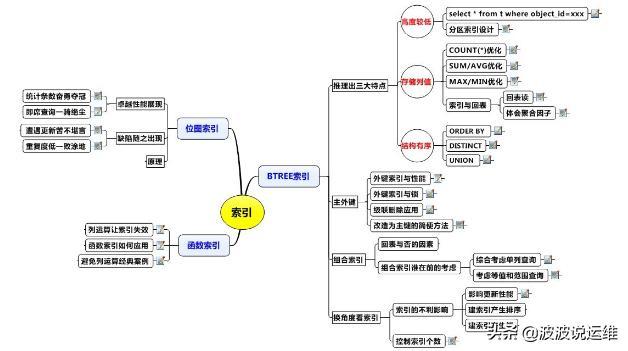
今天主要介绍Oracle数据库的三大索引类型,仅供参考。

一、B-Tree索引
三大特点:高度较低、存储列值、结构有序
1. 利用索引特性进行优化
2. 联合索引
应用场景一:SQL查询列很少,建立查询列的联合索引可以有效消除回表,但一般超过3个字段的联合索引都是不合适的.
应用场景二:在字段A返回记录多,在字段B返回记录多,在字段A,B同时查询返回记录少,比如执行下面的查询,结果c1,c2都很多,c3却很少。
- select count(1) c1 from t where A = 1;
- select count(1) c2 from t where B = 2;
- select count(1) c3 from t where A = 1 and B = 2;
联合索引的列谁在前?
普遍流行的观点:重复记录少的字段放在前面,重复记录多的放在后面,其实这样的结论并不准确。
- drop table t purge;
- create table t as select * from dba_objects;
- create index idx1_object_id on t(object_id,object_type);
- create index idx2_object_id on t(object_type,object_id);
等值查询:
- select * from t where object_id = 20 and object_type = 'TABLE';
- select /*+ index(t,idx1_object_id) */ * from t where object_id = 20 and object_type = 'TABLE';
- select /*+ index(t,idx2_object_id) */ * from t where object_id = 20 and object_type = 'TABLE';
结论:等值查询情况下,组合索引的列无论哪一列在前,性能都一样。
范围查询:
- select * from t where object_id >=20 and object_id < 2000 and object_type = 'TABLE';
- select /*+ index(t,idx1_object_id) */ * from t where object_id >=20 and object_id < 2000 and object_type = 'TABLE';
- select /*+ index(t,idx2_object_id) */ * from t where object_id >=20 and object_id < 2000 and object_type = 'TABLE';
结论:组合索引的列,等值查询列在前,范围查询列在后。 但如果在实际生产环境要确定组合索引列谁在前,要综合考虑所有常用SQL使用索引情况,因为索引过多会影响入库性能。
3. 索引的危害
表上有过多索引主要会严重影响插入性能;
4. 索引的监控
- --监控
- alter index [index_name] monitoring usage;
- select * from v$object_usage;
- --取消监控:
- alter index [index_name] nomonitoring usage;
根据对索引监控的结果,对长时间未使用的索引可以考虑将其删除。
5. 索引的常见执行计划
二、位图索引
应用场景:表的更新操作极少,重复度很高的列。
优势:count(*) 效率高
- create table t(
- name_id,
- gender not null,
- location not null,
- age_range not null,
- data
- )as select
- rownum,
- decode(floor(dbms_random.value(0,2)),0,'M',1,'F') gender,
- ceil(dbms_random.value(0,50)) location,
- decode(floor(dbms_random.value(0,4)),0,'child',1,'young',2,'middle',3,'old') age_range,
- rpad('*',20,'*') data
- from dual connect by rownum <= 100000;
- create index idx_t on t(gender,location,age_range);
- create bitmap index gender_idx on t(gender);
- create bitmap index location_idx on t(location);
- create bitmap index age_range_idx on t(age_range);
- select * from t where gender = 'M' and location in (1,10,30) and age_range = 'child';
- select /*+ index(t,idx_t) */* from t where gender = 'M' and location in (1,10,30) and age_range = 'child';
三、函数索引
应用场景:不得不对某一列进行函数运算的场景。
利用函数索引的效率要低于利用普通索引的。
oracle中创建函数索引即是 你用到了什么函数就建什么函数索引,比如substr
- select * from table where 11=1 and substr(field,0,2) in ('01')
创建索引的语句就是
- create index indexname on table(substr(fileld,0,2)) online nologging ;
display-namedefaultroot/display-name servlet servlet-namedebugjsp/servlet-n...
SQL可以独立完成数据库生命周期中的全部活动,包括定义关系模式、录入数据、建立...
信号章节 -- 信号章节总体概要 信号基本概念 信号是异步事件,发送信号的线程可...
MySQL 运维 - 从零开始学习 一、数据库类型 ? 常见的数据库类型 二、数据库管理...
在用java进行web业务开发的时候,对于页面上接收到的参数,除了极少数是步可预知...
本文重点给大家介绍AjaxFileUpload+Struts2实现多文件上传功能,具体实现代码大...
我们在用ajax请求数据时,可能会遇到一次点击多次触发的可能。 (比如说:ajax ...
在Sun的Java JDK 1.40版本中,Java自带了支持正则表达式的包,本文就抛砖引玉地...
本文实例为大家分享了JS实现纸牌发牌动画的具体代码,供大家参考,具体内容如下 ...
无论是Windows还是macOS,都少不了各种小工具的加持。作为操作系统中必不可少的...